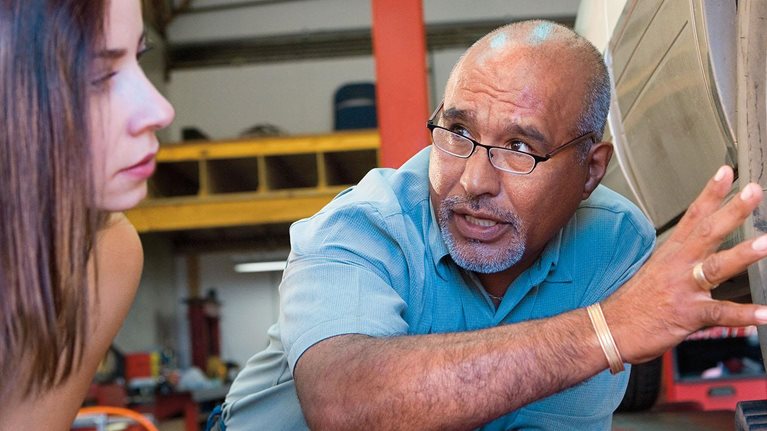Across the business landscape, savvy executives are increasingly asking the same question: What do my customers want? They are coming to realize that, whatever they offer, they are in the customer-experience business. Technology has handed consumers growing power to choose how and where to buy products and services, and customer-friendly leaders such as Amazon and Apple steadily raise customer expectations for superior service ever higher. We find that how an organization delivers for customers is beginning to be as important as what it delivers. Our research shows that companies that systematically put customers first create inroads against competitors, build cultures that benefit employees as well as customers, and improve the bottom line from both the revenue and cost sides.
Stay current on your favorite topics
The customer-experience phenomenon may seem far removed from the work of federal, state, and local governments, but it offers important lessons. True, agencies rarely have a direct competitor from which they are trying to capture market share. Nor do disruptive start-ups typically emerge to steal their customers. Yet the rationale for agencies to improve the citizen experience may be just as powerful.1 For enhancing an agency’s ability to achieve its stated mission, outperforming in efforts to meet budget goals, and engaging employees in a superior culture of citizen service, customer-experience improvement efforts offer public agencies far-reaching lessons.
Central to any successful customer-experience program is a focus on identifying, understanding, and mastering the customer journey: the complete end-to-end experience customers have with an organization from their perspective. In essence, improving citizen experiences requires more rigorous effort to improve citizen journeys across channels and products. Like customer-focused businesses, most agencies focused on serving citizens typically think about touchpoints: the individual transactions through which citizens interact with the agency and its offerings. But this siloed focus on individual touchpoints misses the bigger, and more important, picture: the citizen’s end-to-end experience. Only by looking at the citizen’s experience through his or her own eyes—along the entire journey taken—can you really begin to understand how to improve performance meaningfully.
Journeys can be long, stretching across multiple channels and touchpoints, often lasting days or weeks. For example, for a new student loan or a mortgage, an individual’s journey might include learning about options, submitting an application, setting up an account, resolving problems, and so on. Journey-based thinking often means reframing an agency to put the customer, rather than the traditional organization chart, at the center of the strategy. In our experience, it is possible to apply science to defining an agency’s highest-priority journeys and measuring customer satisfaction across those journeys, not just at individual touchpoints. It is also possible to apply design elements necessary to structure the organization in a customer-centric manner and make it adaptable as citizen needs and conditions change.
Mission critical
Browse the “about us” section of the website for any US government agency, and it immediately becomes clear how vital are the missions that departments are tasked to carry out. Their success can be gauged by clear and definitive measures, not only in terms of operations but also in terms of their impact on the lives of US citizens (Exhibit 1).

But, to execute those missions successfully, citizens must actively engage with the agencies that exist to serve them. That entails effectively learning about the services, understanding the value to the individual, and being able to meet the requirements. For example, the Department of Veterans Affairs cannot provide the best possible care for veterans and their families if veterans aren’t able to enroll in the system, find the correct information online or over the phone, or determine what benefits they are entitled to receive. Similarly, the Education Department’s Federal Student Aid program cannot help the neediest students if those students do not engage because they aren’t aware of the services that are available, or if they find completing the paperwork overly complex or time consuming (see “Pioneering a customer-experience mind-set for Federal Student Aid programs”).
Would you like to learn more about our Public Sector Practice?
Our research in the private sector shows that satisfaction with an experience is directly linked to loyalty measures (Exhibit 2), indicating that an improved experience drives a desire to engage more frequently and more consistently with a given organization. A focus on improving the citizen experience—for instance, making it easier to complete a transaction in a more timely manner—can improve the citizen’s voluntary compliance, make the delivery of services more cost effective, and improve the citizen’s trust in government.

Although several agencies are solely focused on providing services for relevant citizen populations, others are revenue funded and have related targets. For agencies with such revenue responsibilities, like the National Park Service or the Export-Import Bank, a focus on improving the citizen’s experience can create opportunities to provide additional products and experiences as well as reduce churn. Our research has shown that improved experience has a measurable impact on a customer’s willingness to increase the overall services purchased from an organization (Exhibit 3). Across private industries, successful projects for optimizing the customer experience typically achieve revenue growth of 5 to 10 percent.2

Improvements to citizen experience need not come at a heavy cost to operating expenditures or in the form of large capital investment. In our experience, when customer-experience programs are executed systematically, they usually reduce costs or are, at worst, cost neutral. An effective program can identify the experiences that matter most to citizen users, and it will focus investment in areas that improve the experience while demoting, automating, or eliminating operations that customers do not value. Across private industries, successful projects for optimizing the customer experience typically achieve cost reductions of 15 to 25 percent within just two or three years.3
A virtuous cycle
Improving the citizen’s experience can also reverse slumping employee engagement at agencies themselves. According to the Office of Personnel Management’s 2016 Federal Viewpoint Survey, satisfaction and engagement of government employees have been stagnant since 2012. In the study, engagement has been flat at 65 percent since 2012, with some agencies scoring as low as 35 percent engaged. The global satisfaction index decreased by about 3 percent, with some agencies scoring as low as 34 percent satisfied.4 As with most private-sector companies, it’s clear that government agencies struggle to maintain engagement among their workforce.
Superior employee engagement and citizen experience reinforce each other. Studies identify a direct link between employee engagement and a positive customer experience.5 We’ve also found that a program focused on improving the experience and engagement of frontline workers can have a significant positive impact on the customer experience. In our work with clients, we’ve also found that the reverse is true: a focus on customer experience has an equally important impact on employee engagement and satisfaction. Well-run customer-experience programs give employees a focus and a common, unifying purpose centered on customers. We’ve found that most employees, even those who appear to be underperforming, want to do well and deliver a great experience for the customer base, but many lack the tools or skills necessary to live up to expectations.
A thoughtful citizen-experience improvement program can remove workplace barriers and provide employees with the knowledge, skills, tools, and capabilities necessary to do their jobs to the best of their abilities. Finally, we often see that what’s good for the customer is also good for the front line. Customer-experience programs aim to reduce complexity, friction, and unnecessary work from customer-facing processes, which also leads to reducing job complexity and improving time allocation and satisfaction. For example, a call center may identify how to segment call volume in a way that reduces or automates responses for low-value requests, so that employees are free to spend more time solving difficult issues with customers, deliver a great experience, and find more satisfaction in their daily work.
A significant challenge
Government agencies have considerable ground to make up in building a more citizen-centric culture. In recent years, satisfaction with government agencies has been declining. In the January 2015 report of the American Customer Satisfaction Index (ACSI),6 satisfaction with federal agencies fell for the third consecutive year and was 6 percent lower than it had been in 2007. Our research shows that federal-government agencies ranked last in customer satisfaction among 11 industries studied (Exhibit 4).

One reason is that, despite agency efforts to improve, private-sector companies continue to raise the bar on customer service—and in so doing, raise expectations of what people will accept in both the private and public sectors. Within industries, leaders are constantly innovating to improve experiences. For example, JetBlue, a leader in air-carrier customer experience, invests in an immersive-training campus to imbue crew members with its own distinctive brand of customer service. Across industries, disruptors are shifting how people think about experiencing better service. Uber has made hailing a taxi a convenient digital experience, and Airbnb has redefined travel lodging. Through such innovations, citizens come to measure the level of agency service not against traditional government peers but against smooth, personalized, and “always on” experiences they interact with every day.
Keys to improving citizen experience
Our work in both the public and private sectors has shown us that leaders in customer experience have a few things in common, regardless of industry. The lessons learned from this work can be applied to define a clear process for improving citizens’ experience while achieving success measured against mission, revenue, cost, and employee-experience goals. Metrics and effective habits for leading customer-experience efforts can be gleaned from leading practitioners, and case examples can show how these concepts work in practice. At one large international airport, for example, the results have been dramatic. In a recent video, an airport executive describes this customer-experience transformation.
As noted earlier, improving customer experience begins with a focus on the complete experience a customer has with an agency, as seen from the citizen’s perspective.7 That journey has a clearly defined beginning and end, spanning the progression of touchpoints. Citizens don’t know or care who in an agency owns the individual experience of billing, onboarding, service calls, and so forth. From their perspective, these are all part of one and the same journey. The effort of perfecting the most important journeys for customers can be hard, but agencies, by focusing on the task, can provide experiences that make citizens want to engage and continue engaging.
Our work has taught us that the most successful programs of the most successful practitioners have six hallmarks (Exhibit 5). These can be adopted to make significant strides toward a best-in-class customer or citizen experience.

Define a clear aspiration
In large, distributed organizations, a distinctive customer experience vitally depends on a deeply rooted collective sense of conviction and purpose to serve the customer’s true needs. This basic fact must become clear to every employee through a simple, crisp statement of intent: a shared vision and aspiration that’s authentic and consistent with a company’s value proposition. Many government agencies already can clearly articulate such an aspiration. For example, some employees at the US Department of State’s Bureau of Consular Affairs cite a simple rallying cry they’ve informally adopted: “No missed trips!” Even a three-word statement can capture a genuine and easily interpreted goal that can help focus leadership as well as the front line: the job is not simply to issue passports, it is to make sure citizens safely and efficiently reach their destinations. Such a clearly articulated vision for the experience can be easily translated into a set of simple principles or standards to guide behavior throughout the organization. In this way, large, distributed agencies can synchronize their actions, using the aspiration as a guiding light to steer their daily activities.
Develop a deep understanding of what matters to customers
Citizens on their journeys hold agencies to high standards: the best services, with no errors, immediately available, procured with the help of high-caliber employees at low prices. How can agencies determine which of these factors are the most critical to the citizen segments they serve? Which are most critical to achieving their stated mission? Understanding the most important journeys and where opportunities exist, citizen segment by citizen segment, helps an agency maintain focus and have the greatest impact on the satisfaction of its citizens and its own performance.

The CEO guide to customer experience
Fortunately, the advent of big data and advanced analytics has helped organizations parse not only customers’ opinions about what will satisfy them but also customers’ actual behavior related to using the organization’s products and services. Similarly, multiple sources reflecting the voice of the customer—including surveys, social media, and the real-time chronicling of the research and purchase experience—can illuminate how well organizations currently are managing their customers’ journeys. Once organizations have identified the most important journeys and defined their strengths and weaknesses, the process of redesigning and prototyping can begin. For instance, at the Federal Student Aid program, the Office of Customer Experience identified a steady theme of customer conversations: confusion about the loan-repayment process. Based on the importance of this step in the citizen journey and the broad-reaching nature of the issue, the organization consolidated repayment calculators and began allowing customers to import their loan information directly into the new calculator.
Use behavioral psychology to manage expectations
Leading customer-experience players understand that deftly shaping perceptions of underlying operational improvements in the delivery of products or services can generate significant additional value. An increasingly effective tool at these organizations is behavioral psychology, used as a layer in the design process. For example, an organization can design the sequence of interactions with customers to end on a positive note. It can merge different stages of interactions so they seem to take less time and engender a feeling of progress. And it can provide simple options that give customers a feeling of control and choice.
One official at the Internal Revenue Service relates how traditional guidance to tax preparers indicated that taxpayers could expect their tax refunds to be processed within two days. Research showed that while that turnaround time was true on average, most returns were processed within six days, and the mismatch between expectations and typical performance led some taxpayers to complain of “delays.” So the agency lengthened its general guidance for wait times and gave taxpayers a way to check the status of their returns. By adjusting user expectations, the agency improved the customer experience, measured as a decrease in complaints and inquiries, with no actual change in processing times.
Reinvent customer journeys using digital and design thinking
Customers accustomed to the immediacy, personalization, and convenience that define digital “natives” such as Facebook and Google now expect the same kind of service from most of their interactions. Research shows that 25 percent of customers will defect after just one bad experience.8
Agencies can realize significant improvements in citizen experience by digitizing the processes behind the most important journeys. Successful examples from the private sector demonstrate quick efforts where multidisciplinary teams jointly design, test, and iterate high-impact processes and journeys in the field, continually refining and rereleasing them after input from end users. Such methods help high-performing incumbents release and scale major user-vetted process improvements in under 20 weeks. This methodology helps leaders in customer experience speed up their operations.
To achieve similar results, agencies must embrace new ways of working. We see one such example of innovation at the Social Security Administration. For years, the ACSI has consistently ranked the SSA’s Retirement Estimator as one of the government’s top online services.9 A source of its success was that the program’s design and initial development phase incorporated human-centered design techniques. During a three-month period, SSA conducted focus groups and small-group usability testing to iteratively test design assumptions. The testing started with low-fidelity prototypes, building in sophistication with each testing phase, and ended with the final working prototype. The agile “tech company” style of working has resulted in a high-value online service for the SSA’s customers.
Read our latest thinking on customer experience in government
Use customer journeys to empower the front line
Every leading customer-experience company has motivated employees who embody the customer and brand promise in their interactions with consumers and are empowered to do the right thing. Companies centered on customers engage them at every level of the organization; employees work directly with them in retail settings, take calls, and get out into the field. In the early years, for example, Amazon famously staged “all hands on deck” sessions during the year-end holidays, a tradition that lives on in the employee-onboarding experience.10 Some organizations create boards or panels of customers to provide a formal feedback mechanism.
From leading practitioners, we’ve distilled four simple rules for building a sense of frontline engagement. First, listen to employees and establish mechanisms to address their issues and needs. Next, hire for attitude, not aptitude; in other words, if you want to provide friendly service, hire friendly people. Interviewing prospective employees in groups, as JetBlue Airways does, is one way to observe how they interact. Then give your people a purpose, not rules, so the company sets clear expectations and lets employees know that it trusts them to do their jobs. Finally, tap into the creativity of your frontline employees by giving them the autonomy to do whatever they can to improve the citizen experience and fix problems themselves.
The National Cancer Institute has done some groundbreaking work in customer research to empower their information specialists with the knowledge to do their jobs effectively. Institute leaders realized that in order to meet the needs of cancer patients, they needed clearer insight into the lives of those they were serving. In one innovative initiative,11 the NCI created personas and customer journeys for Hispanic citizens, so the information specialists could better understand the citizens’ specific needs when faced with a cancer diagnosis. Each persona included details such as language preferences, where and how citizens primarily accessed their health information, and which treatment questions were likely to be most important to them. These detailed personas provided valuable insight into the lives of patients, helping the NCI web team and call-center agents better publish useful information and answer calls at the NCI contact center with the empathy and care that cancer patients need and deserve.
To improve constantly, establish metrics and a governance system
The key to satisfying customers is not just to measure what happens but also to use the data to drive action throughout the organization. Leading practitioners start at the top, with a metric to measure the customer experience, and then cascade downward into their key customer journeys and performance indicators. To move from knowledge to action, companies need proper governance and leadership. Best-in-class organizations have governance structures that include a sponsor—a chief customer officer—and an executive champion for each major kind of cross-functional customer journey. Full-time teams carry out their day-to-day work in the existing organization, because to succeed, the transformation must take place within normal operations. To foster understanding and conviction, leaders at all levels must serve as role models for the behavior they expect from these teams, constantly communicating the changes needed. Formal reinforcement mechanisms and skill-building activities at multiple levels of the organization support the transformation as well.
For instance, the General Services Administration’s Office of Citizen Services and Innovative Technologies (GSA/OCSIT) used a Government Customer Experience Index to jump-start their citizen-experience program. To obtain feedback directly from customers, GSA/OCSIT used the questions from the government’s Digital Government Strategy as a foundation for their survey of the users of the federal government’s official websites, USA.gov and GobiernoUSA.gov, as well as the National Contact Center, and other citizen-facing channels. By analyzing questions that gauged overall satisfaction, ability to complete intended tasks at websites or contact centers, and basic loyalty, they were able to compute a single customer-experience index, which was then used to create action plans addressing critical issues.
Mastering the concept and execution of an exceptionally good citizen experience is a challenge, but it can help government agencies reach new heights against their stated missions, achieve revenue and cost targets, and improve the overall engagement of their employees. By focusing on the citizen’s overall journey and scientifically applying lessons learned from other customer-experience leaders, public entities can gain significant ground in the satisfaction of the citizens they serve.


